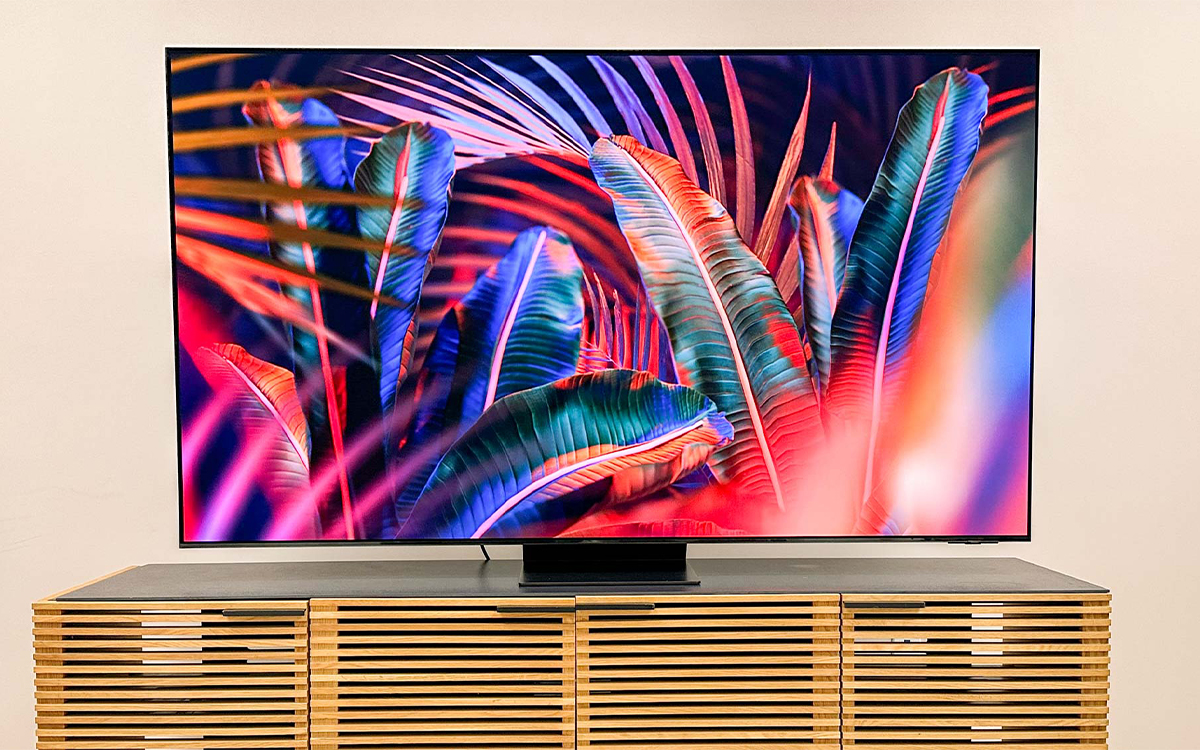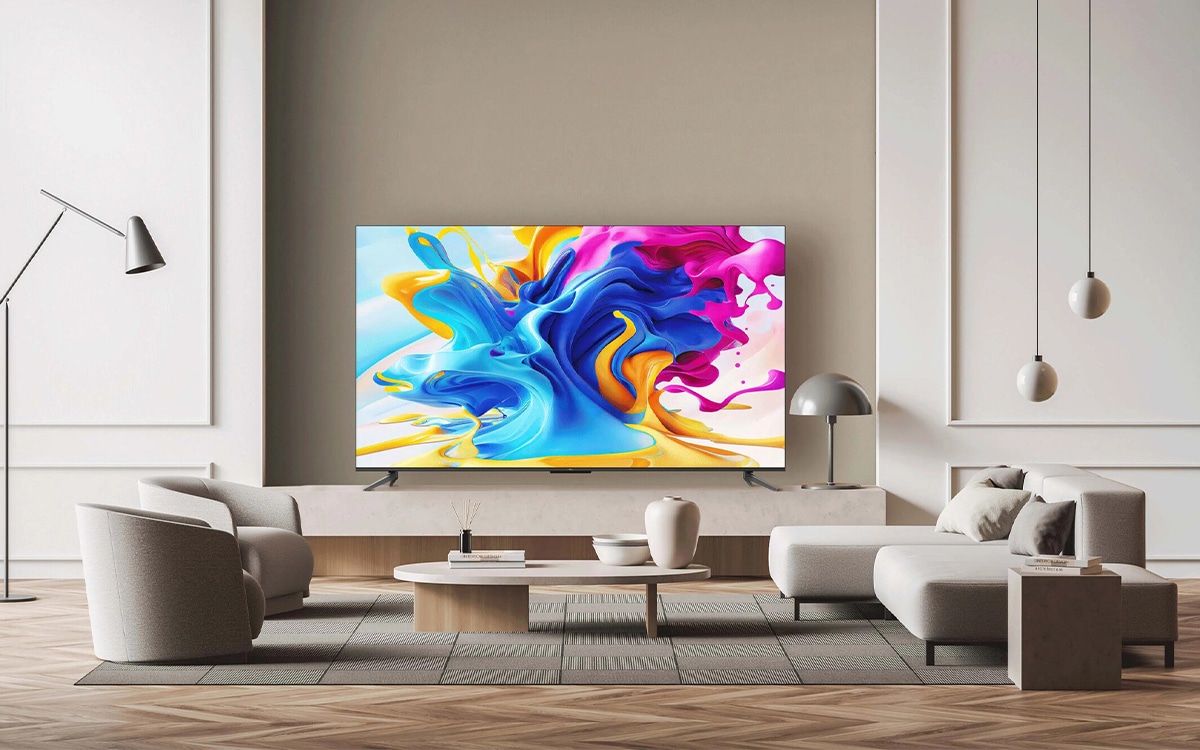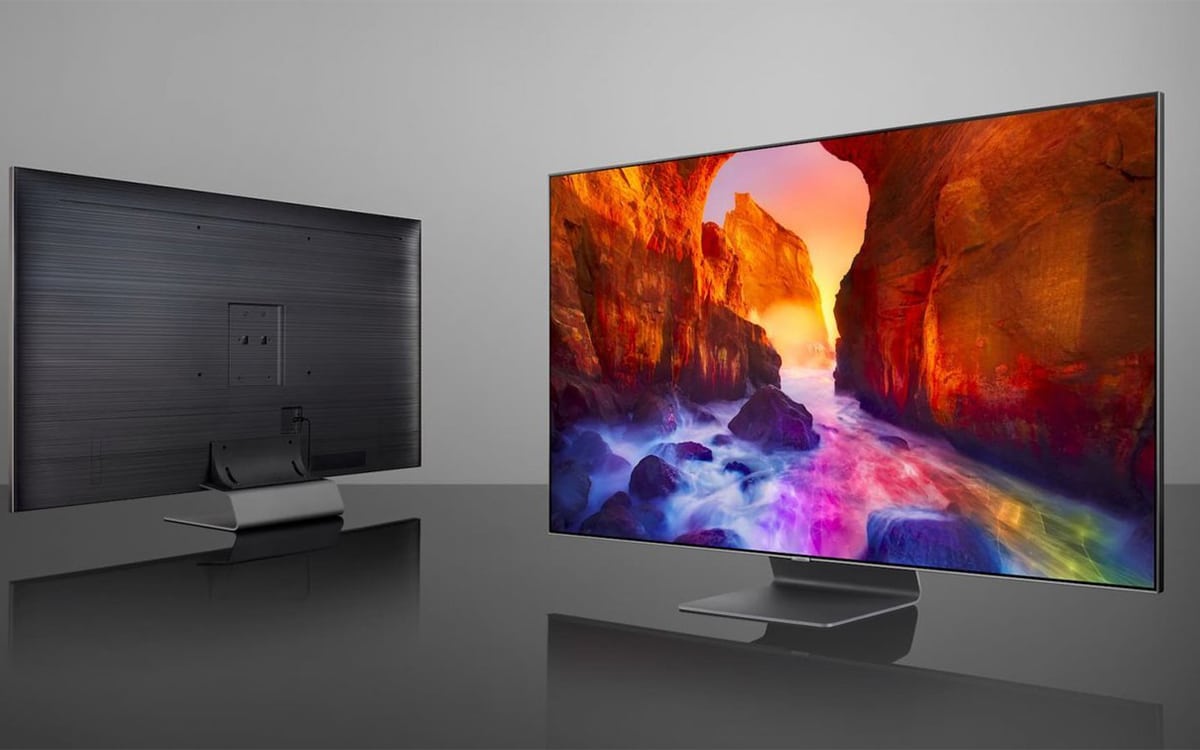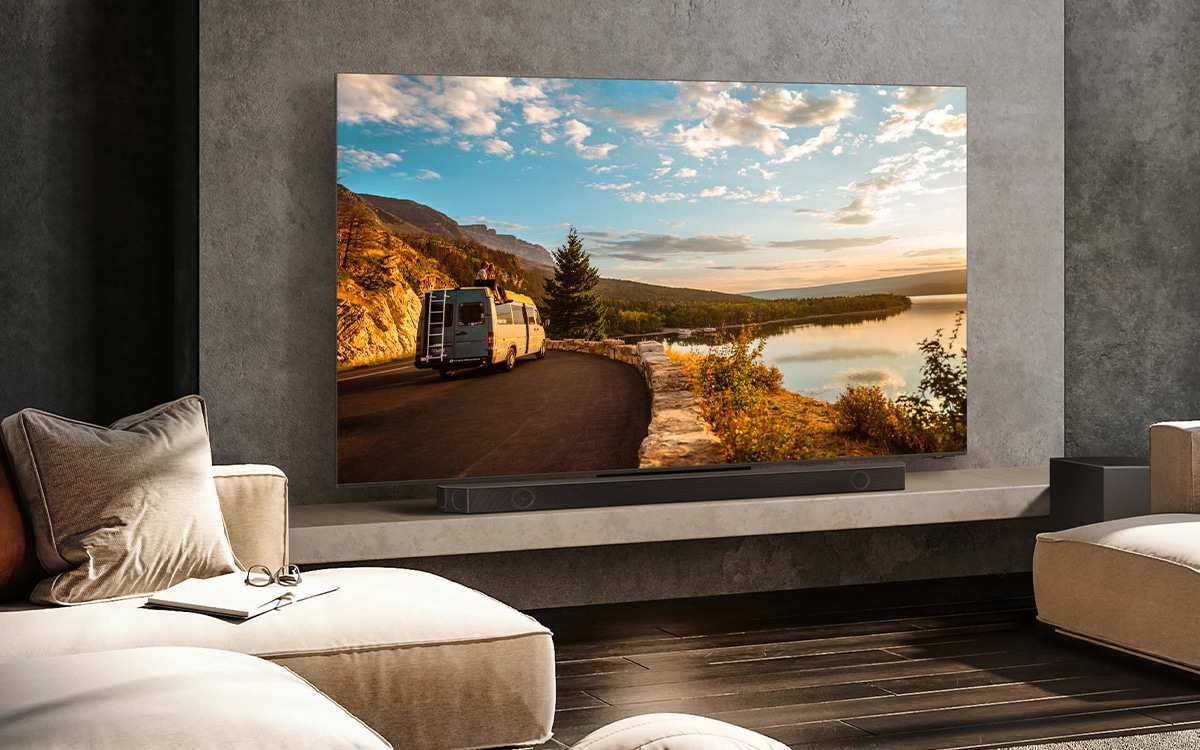And it’s not just screen sizes that have improved over the years. Certainly, TVs are now much larger than they’ve ever been before. But in order to take advantage of these enhanced views, TVs also now employ a wide range of additional technologies. One of the most unique of these technologies is all of the different display types.
From OLED to LED, to QNED, and onward, there are so many different display types that it can often be a bit daunting. Trying to make sense of all of these unique terms while also trying to find that one dream TV can seem like a herculean task. That’s why our Reliant tech experts are here to help.
Found yourself totally dumbfounded when encountering the term “QLED”? Want to know just what it refers to? Then be sure to join in down below as we take a closer look at these unique displays!
What Is A QLED TV?
Let’s start by finding out what the term directly refers to. “QLED” is an abbreviation of “Quantum-dot light-emitting diode”. To the uninitiated, this can sound quite daunting. Just what exactly is a quantum dot?
What makes a QLED TV unique is their use of quantum dots to create images with far richer colour, and denser visual detail. Quantum dots are powered up with an electrical current, which then causes them to emit light of highly specific colours. Changing the amount of electricity the quantum dots receive results in them releasing light of different colours.
QLED TVs make use of quantum dots, which are small quantum-sized semiconductors that produce very specific colours for a richer and more detailed image. QLED TVs are known for being incredibly colourful!
QLED TVs are well known for their colour-enhancing benefits. Images on QLED displays simply appear much richer, which allows for a greater density in every image. With more colours to play around with, contrast looks stronger, and this leads to a much greater sense of detail. Every shape moving on the screen appears tangible! QLED TVs are also able to recreate colours that are true to life. This means that objects on-screen boast exactly the colours they have in real life!
What Is The Difference Between QLED And OLED?
Because their names are so similar, OLED and QLED TVs are very often confused with one another. The key difference between the two is in how they project an image. We’ve written an extensive guide to the difference between QNED, QLED and OLED TVs.
An OLED tv display makes use of “Organic light-emitting diodes”. These are often referred to as “Pixels”. The pixels are arranged in their millions across the length of a given TV screen and are responsible not only for rendering images but also for producing their own light. This means that OLED TVs are manufactured entirely without backlights!
A QLED TV, instead, obviously use quantum dots to render images. However, unlike OLED pixels, these quantum dots cannot produce enough light to be visible by themselves. Once these quantum dots have rendered an image, a backlight is then shined through them to make it visible!
How Do Quantum Dots Work?
Part of what makes quantum dots so interesting is the scale at which they work. Quantum dots are actually tiny semiconductors that operate at the quantum level. With the naked eye, individual quantum dots simply can’t be seen.
We mentioned above that quantum dots emit light of specific colours depending on how much energy they receive. The best way to picture this is to imagine the atoms that makeup everything in the world around you. When atoms are subjected to high amounts of energy, they then release high amounts of energy of their own! Most commonly, this energy is released in the form of light!
Quantum dots, however, are specially designed to release light with specific colours, depending on how much energy they receive.
This may all still sound very technical, but don’t worry. Suffice it to say that the unique nature of quantum dots allows QLED displays to be much more colourful than other competing displays.
Are QLED TVs Worth Buying?
Now that we’ve outlined what makes QLED TVs unique, the prevailing question is likely whether these displays are worth the money!
In general, we’d say that QLED TVs are totally worth buying. They offer a number of amazing visual benefits that can make certain content look amazing. But your mileage with a QLED display will depend entirely on what you want out of a TV.
QLED TVs come with a number of distinct benefits. For instance, they’re incredibly colourful, and they offer immense brightness levels. However, they do have a slightly higher level of input lag due to how they operate!
Let’s take a look at some of the unique benefits and drawbacks of QLED TVs. So you can decide whether QLED technology is right for your TV needs!
Pros
True-To-Life Colour
We’ve mentioned more than a number of times just how colourful QLED TVs are. But it really cannot be overstated what a difference this makes! QLED TVs are perfect for cinephiles, as they allow the biggest cinematic spectacles to shine in all of their glory. You can also count on a QLED TV to render colours realistically and consistently.
QLED TVs are made for lovers of film and TV. Their rich colour depth helps every image to pop, and they’re specifically fantastic when used to display HDR videos!
High Brightness
One factor that puts QLED TVs well above OLED TVs is their satisfying brightness levels! While OLED TVs still look great, they ultimately can’t pump out as much light through their individual pixels. QLED TVs, on the other hand, rely on backlights to project images outward. These backlights can achieve some seriously high brightness levels.
For night-time viewing, this can result in truly engaging viewing. Bridging the gap between you and your favourite fictional worlds. Higher brightness levels are also beneficial in the daytime! If you have a room that is often subjected to bright light, then you can be sure that your QLED TV will still be easy to see. Simply crank up the brightness, and bright sunlight will no longer pose an obstacle!
Improved Contrast
Contrast is often overlooked when it comes to finding a high-quality TV display. With a higher contrast ratio, it becomes much easier to spot individual shapes and details in every image. Thanks to QLED TVs being able to replicate a massive spectrum of colours, no two shapes ever blur into one another, because there are so many different colours the screen can replicate!
QLED TVs can produce millions more colours than other displays. As such, shapes on screen don’t run the risk of blending into one another! With more available colours, there’s a vastly improved contrast ratio!
Film fans will get a true kick out of QLED TVs. Especially when enjoying highly colourful and action-packed blockbusters.
They’re More Affordable Than Ever
Nowadays, QLED TVs are incredibly inexpensive and are much more accessible than they once were.
If you’ve been on the fence about grabbing a QLED TV of your own, there’s literally never been a better time to do it!
Cons
Unsatisfying Black Values
Unfortunately, a key issue with QLED TVs is one shared by other backlight-dependent displays. Because backlights are always pumping light through the screen, it means that it’s tougher for true black values to be rendered accurately.
This is one area where OLED TVs vastly overshadow the competition. OLED pixels don’t just produce images and their own light. They can also be completely turned on and off as needed. This means that when the pixels are off, they produce no light, and therefore create a truly black image. When QLED displays need to create black areas of an image, light still bleeds through those same areas, resulting in a dull grey!
QLED TVs are thus not perfect at creating darker tones that are suitable for horror films or games. If you want true black values from your TV, your best bet is an OLED model!
Slow Response Times
QLED TVs need to put in a little more effort to render such accurate colours in every single image. While this does result in a more crisp image with a density of detail, it does also result in high input lag!
The response time of a TV refers to how quickly a rendered image from an input source, such as a console or media player, can appear on the screen. When input lag is higher, it means that it takes longer for rendered images to be displayed. This means that if you were to pause a Blu-ray disc that’s displaying on a QLED TV, there would be a slight delay between pressing the button, and the footage actually pausing on-screen.
Ultimately, the higher input lag of a QLED TV only really amounts to around 1 or 2 milliseconds. To most people, an input lag of only a few milliseconds is almost unnoticeable! However, for certain TV users, these extra milliseconds can be incredibly disruptive!
QLED TVs have a few extra milliseconds of input lag. For most people, this simply won’t make a difference. For gamers, the extra milliseconds can be a total buzzkill, ruining their sense of flow!
For gamers, input lag is key. Even a fraction of a millisecond of latency can decide whether a player comes out victorious. This is why OLED TVs are most often recommended to gamers. They typically have less than 0.2 milliseconds of input lag! The extra milliseconds of input lag found in QLED TVs can leave gamers lacking a sense of control over their games!
Narrow Viewing Angles
Another edge OLED TVs have over QLED TVs is their range of viewing angles. Even if you were to sit at the far edge of an OLED TV, you would still receive the full image. This makes OLED TVs great for viewing parties with numerous viewers! QLED TVs, on the other hand, have more limited viewing angles. If you sit at too sharp of an angle from a QLED display, you’ll quickly find that the image appears muted and incomplete.
The reason for this again comes down to how OLED pixels operate. OLED pixels provide their own light. This means that the light source of an OLED TV is close to the surface of the screen. In turn, OLED pixels can project their light in all directions.
QLED TVs instead rely on a backlight. The backlights are placed deep behind all other layers of the screen. In order to see the image on screen, the light first has to travel through all of the layers of the OLED display. When you try to view this light from an odd angle, the light is scattered and has trouble reaching you.
They’re Difficult To Repair
It’s important to take fantastic care of a QLED TV. While QLED TVs are definitely durable, they can still be easily damaged if they are bumped, or accidentally knocked from their perch. And when QLED TVs are damaged, they can be incredibly difficult and costly to repair.
QLED TVs, of course, make use of some highly specialised panel tech to produce such vibrant images. Sourcing the materials for this can often be quite costly. As well as this, when a single part of a QLED panel is damaged, the entire thing needs to be repaired. This means that even the slightest damage can result in costly repairs!
In some cases, it can also be more cost-effective to simply buy a brand-new QLED TV!

What Should You Consider When Looking For A QLED TV?
If you’re a film or TV fan hoping to make the most of the cinematic form, then it’s likely all of this talk of QLED TVs has piqued your interest. But QLED TVs are never built equal. There are all kinds of observable variances that can complicate your choice of QLED TV. Let’s take a look at some of the most important things to consider when buying a QLED TV of your own.
Screen Size
It’s best to start by considering the total screen size of your new QLED TV. By choosing a screen size, you’ll be able to narrow down your options and make your selection much simpler! Your choice of screen size will also be closely tied to your viewing experience.
Almost instinctively, you might gravitate right to the largest TVs on the market. We’ve all dreamt of having the largest TV in the world, right in our living room. However, you need to make sure to be reasonable with your choice. A TV that’s too big or too small is uncomfortable to watch.
QLED screens look great at just about any size. But you’ll want to make sure your QLED TV fits into your home and that you have enough space to take it all in!
Bigger screen sizes are great for enjoying streaming content such as film and TV. Especially with a QLED display. QLED TVs are renowned for packing tons of detail into every single image. On a bigger screen, it’s much easier to spot all of these details. However, this isn’t to say that QLED doesn’t also look great on smaller screens. No matter the size of the TV screen you get, it will benefit greatly from QLED’s colour-richness.
You can ensure your TV isn’t too big or too small by remembering the following handy trick. The optimal distance from which to watch any TV is 1.2 times the length of the screen. This will ensure you always get a perfect view of the action!
HDR Support
HDR support is crucial for getting a truly great QLED experience. However, many QLED owners very often overlook its importance. HDR is actually a unique video format that is designed to take full advantage of a TV’s colour capabilities. QLED TVs were practically made for enjoying the best of HDR video! The colourful quantum dots are able to accurately recreate every colour of HDR.
Not all QLED TVs are compatible with HDR, so it’s important to check each model you consider. Luckily, manufacturers are keen to let you know whether their TV models are HDR-compatible. So you won’t have to trawl through pages and pages of jargon just to find the right model.
Smart TV Features
Most likely, you’re going to use your new QLED TV to tune into all of the latest delights from the entertainment world. From blockbuster megahits to deep and introspective TV crime dramas. If you want to enjoy as much as you can, then smart TV features are absolutely crucial.
Smart TVs can connect directly to the internet and are fully compatible with all of your favourite streaming services. This means you can easily jump right into your favourite shows, and easily move from one service to the next.
With improved smart features, it’s much easier to find that all-important content that shows off what your QLED display can do. To make the most of these features, we recommend looking for TVs with greater internal processors!
In your search for smart TV features, be sure to look out for a dependable processor. Smart TV processors are responsible for keeping all of its various functions working at their best. The better the processor is, the more efficient the smart TV is. If you want to easily hop between channels and streaming services, then you’ll want the most efficient and powerful processor.
Price
It’s worth having a strong sense of your budget from the very beginning. This helps to ensure that you stay on track with your QLED TV hunt. However, it’s also important to be somewhat flexible with your plans. TVs can vary massively in terms of price, often correlating to the number of unique features they boast. If you want access to specific features you may have to spend a little more than you initially expected.
This is why it’s so important to dedicate some time to considering what you want out of your TV. If you’re sure of the types of features you’re looking for, then you’ll be able to put together an accurate budget. It will also ensure you don’t spend too much on a TV full of features that are useless to you. And that you don’t spend too little on a TV that barely functions!
Do QLED TVs Look Better With 4K Or 8K Resolutions?
The reason we didn’t cover resolution in the section just above is that it ultimately does not make too much of a difference! QLED TVs most commonly have either 4K or 8K resolutions. These resolutions both look absolutely fantastic on a QLED display. But there’s nothing that suggests one is better than the other for QLED efficiency.
QLED displays look great at any resolution. QLED technology always results in a greater density of colour in every image, no matter the resolution of the screen. Just be sure to choose a suitable resolution for your screen size.
However, your choice of resolution might be affected by your choice of screen size. If you’re planning on purchasing a 98-inch TV, for instance, then you might as well opt for 8K. Images at this resolution look best on the biggest screens possible. If you’re looking for a TV on the slightly smaller end, such as a 43-inch TV, then you might want to save more by opting for 4K!
Are QLED TVs Good For Gaming?
We’ve mentioned already that QLED TVs have much slower response times than OLED TVs. Ultimately, this does mean that OLED TVs are much better for competitive gamers than QLED TVs. However, we wouldn’t want to suggest that QLED TVs are totally without merit for gamers.
The enhanced colour offered by QLED TVs can actually help to give gamers a slight competitive edge. With more detail present on the screen, it becomes much easier to spot opponents in the heat of the moment!
Many consoles are also compatible with HDR video formats. As such, your games can be presented with far richer colour when paired with a QLED display. QLED displays are therefore great for those players who want to curl up with an exciting story. With a QLED display, digital worlds are rendered with a greater sense of detail and scale. Story-focused games are less focused on split-second decisions, so won’t be negatively impacted by slightly higher input lag!

Are QLED TVs Susceptible To Screen Burn-In?
If there’s one thing that keeps modern TV owners awake at night, it’s the dreaded screen burn-in. This proverbial boogeyman is a condition that involves an image being burned directly into a TV’s screen. Luckily, if you have a QLED TV, you can rest easy at night. QLED TVs are far less susceptible to screen burn-in, especially compared to OLED TVs.
OLED TVs are susceptible thanks to their use of specialised pixels. Because OLED pixels produce their own light, they can burn out at an individual rate! As such, if you leave a bright image on pause on an OLED display, it leaves an impression on the screen itself. The brightest pixels will have burned out significantly, this will prevent them from lighting up quite as brightly.
One of the greatest benefits of QLED TVs is their resistance to screen burn-in. QLED backlights are much easier to repair and replace than individual OLED pixels! QLED TVs are incredibly hardy, and built to be well-used!
It’s possible for QLED backlights to burn out and stop producing as much light. But repairing this issue is much easier. You’d only need to repair a few burnt-out backlights. If any OLED pixels are burnt out, you will need to replace the entire OLED panel!
How Much Electricity Do QLED TVs Consume?
Ultimately, because QLED TVs make use of backlights (which can be incredibly bright), they do tend to consume much more electricity than OLED TVs. However, they do not consume a dramatic amount more energy than other display types. So don’t worry that a QLED TV will dramatically increase your bills!
How much electricity a QLED TV consumes will depend entirely on the model. Factors such as screen size, resolution, and the number of smart features can all impact how much energy a QLED TV consumes. As such, we can’t say precisely just how much energy these TVs tend to consume.
If you’re energy-conscious, we’d recommend opting for a QLED TV with a smaller size, fewer features, and a lower resolution. When using the TV, we would also recommend lowering the brightness level, and turning it off whenever you’re not using it!
How Long Do QLED TVs Last?
QLED TVs can last anywhere between 70,000 to 100,00 total hours of use. This makes them incredibly dependable displays that you can count on to be by your side for years to come!
This is quite similar to the total lifespan of an average OLED TV.
If you want a QLED TV screen to last its full lifespan, or maybe even longer, there are actually quite a few things you can do to improve its health! Let’s take a look at them now!
How Can You Help A QLED TV To Last Longer?
Turn It Off
Here at Reliant, we love TVs more than anything. So we’d never suggest permanently keeping your TV switched off! Instead, our recommendation is to turn yours off whenever you’re not watching it. By only turning your TV on when you’re fully using it, you can ensure you make the most of every single one of its total hours of use.
Turning your TV off between uses ensures the components have time to rest, which keeps them in good health!
Use Surge Protection
Surge protection is highly recommended for any type of TV display. Surge protection devices are specially designed to absorb excess electricity sent from your wall socket. This helps to ensure that energy surges don’t put your QLED TV at risk.
Position Your TV Safely
To ensure your QLED TV’s safety, it’s important to ensure you store it just right. If you’re planning on placing it on a TV stand, be sure that its legs are stable, and that the screen is not larger than the stand itself. This ensures the TV won’t be bumped and sent on a collision course for the floor.
It’s important to find the right place to keep your QLED TV. You want to find somewhere safe and stable, so that it’s never at risk of falling to the floor and being damaged!
If you’re mounting your TV to the wall, be sure that it is securely fixed in space. Be sure to use the right kind of bracket, and to fix it to a sturdy wall!
No matter where you place your TV, be sure plenty of air can reach the unit. Good airflow allows your TV to keep itself cool, which in turn ensures none of its components become overloaded or strained.

Frequently Asked Questions
What Is A QLED TV?
A QLED TV is one that makes use of quantum dot technology. Quantum dots themselves are actually microscopic semiconductors that generate images. These semiconductors can replicate more accurate colours than standard TV pixels. This makes QLED TVs the perfect option for HDR video formats. If you’re a cinephile, then a QLED TV should be right up your alley!
Which Is Better QLED Or OLED TV?
It depends on what you want out of it. If you want a TV that’s perfect for showing off films, then QLED is the right choice. QLED makes HDR content look amazing, and offers a great contrast ratio. OLED TVs, on the other hand, are great for gamers. They have lightning-fast response rates that give them a fantastic competitive edge.





